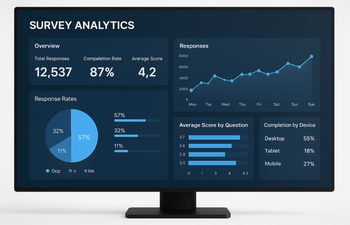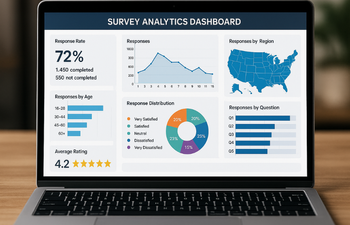The Art of Timing: When’s the Best Time to Send a Survey?
Master the art of timing: Discover the best time to send a survey and increase your response rates with proven strategies.

Introduction
In today’s hyper-connected world, data is power, but only if it’s accurate. One of the most overlooked aspects of gathering actionable insights is timing. You might have the perfect survey, a well-segmented list, and a compelling subject line, yet if your timing is off, you’ll end up with crickets. Sending your survey at the wrong time can mean the difference between insightful responses and digital tumbleweeds.
For more on maximizing survey engagement, see How To Create An Online Survey: 7 Proven Steps for Success.
The art of timing a survey isn’t just about picking a random day and clicking "Send." It’s a strategic act that blends psychology, behavioral insights, and analytics. Let’s delve deep into when’s the best time to send a survey, why it matters, and how you can maximize engagement.
Why Timing Is Everything for Surveys
Survey timing is more than convenience, it's about engagement. Respondents are more likely to participate when they are mentally available and emotionally inclined. Timing can directly influence:
- Open rates
- Click-through rates
- Completion rates
- Quality of feedback
Even the best-crafted questions fall flat if your audience is distracted, overwhelmed, or simply uninterested in that moment.
Psychological Readiness and Survey Fatigue
Human psychology plays a critical role in survey success. When people are tired, rushed, or emotionally drained, they’re less likely to respond thoughtfully, or at all. Send your survey too late at night, and they might ignore it. Send it too early in the morning, and it could get buried under more urgent emails.
Survey fatigue also builds up. If you’ve sent multiple surveys in a short span, people may tune out completely. Timing isn’t just about the clock; it’s about pacing and rhythm too.
Best Days to Send a Survey
According to numerous studies, these are the best days to get higher engagement:
Avoid Mondays (email overload) and Fridays (mental checkout). Weekends are a toss-up, some B2C audiences may engage better, but B2B users are generally offline.
Best Times of Day for Survey Engagement
Morning hours between 9–11 a.m. generally perform best. People are settling into their day, and inboxes are fresh. Another effective window is post-lunch around 1–3 p.m. when there's a lull in productivity.
Different Audiences, Different Clocks
A universal schedule won’t work for everyone. Consider the habits of your audience:
- B2B Professionals: Likely to respond during work hours.
- Stay-at-home Parents: May be freer after school drop-offs or evenings.
- Students: Late afternoons or evenings are best.
Tailor your timing to fit your audience’s daily rhythm.
Event-Based Survey Timing
The closer the survey is to the event, the better the feedback. Whether it’s a webinar, a hotel stay, or a customer support interaction, capitalize on immediacy. Send your survey within 24–48 hours to capture raw, unfiltered impressions.
Avoiding Survey Blackout Periods
There are times when surveys almost always underperform. Avoid sending surveys:
- On major holidays
- During company-wide breaks
- Late Friday afternoons
- Early Monday mornings
Use calendar insights to steer clear of these survey dead zones.
Email Survey vs. In-App vs. SMS: Timing Variations
Each medium has its own prime timing:
Real-Time vs. Delayed Surveys
Real-time surveys often yield better insights. If someone completes a purchase or finishes a call with support, ask for feedback right then and there. But for more strategic or reflection-based surveys (like annual reviews), delay might be necessary for a more holistic response.
The Impact of Time Zones
If your audience spans multiple regions, send surveys based on localized time zones. A 10 a.m. EST blast won’t reach PST users at the right moment. Use your survey platform’s scheduling tools to stagger send times accordingly.
Using Behavioral Triggers to Perfect Timing
Instead of static scheduling, consider behavioral triggers. Tools like Intercom, HubSpot, and Mailchimp allow for:
- Triggered sends post-purchase
- Follow-ups after chat interactions
- Delayed sends based on engagement level
This approach ensures relevance and timeliness.
A/B Testing Your Survey Send Times
A/B testing isn’t just for subject lines. Test send times by dividing your audience and monitoring which group responds more. Use the insights to optimize future campaigns.
Data-Driven Timing Decisions
Leverage analytics to uncover:
- Highest open rates
- Best engagement periods
- Preferred channels
Platforms like Google Analytics, Mailchimp, and SurveyMonkey offer detailed insights to back your timing strategies with hard data.
Frequency Matters Too
How often you survey is just as important as when. Over-surveying leads to burnout. Space out your requests and honor survey fatigue.
Optimizing Mobile vs. Desktop Survey Timing
Mobile users are more likely to respond on-the-go, while desktop users may take their time. Consider that:
- Mobile responses peak during commute hours or late evening.
- Desktop engagement occurs mostly during business hours.
Segmenting by Engagement Level
Not all users engage the same way. Segment your audience into:
- High responders
- Occasional responders
- Inactive users
Customize your timing strategy accordingly.
Survey Reminders: When and How Often?
A gentle reminder 3–5 days after the original send can nudge completion. A second reminder a week later, with a tweaked message, may catch those who were too busy the first time.
Time-Sensitive Offers and Urgency
If your survey offers an incentive, such as a gift card or discount, highlight the deadline in both the email and survey to drive urgency.
Survey Timing for Different Purposes
Tailor the timing based on the survey type:
Cultural Considerations in Timing
Timing norms vary by region. In some countries, weekend communications are fine. In others, they're frowned upon. Understand your audience's cultural expectations.
Tools to Automate Survey Timing
Use automation tools like:
Monitoring and Adapting Over Time
The best timing strategy today might flop tomorrow. Monitor results, tweak strategies, and stay agile. Trends shift. So should you.
If you're interested in how survey length impacts data quality and response rates, check out Short vs. Long Online Surveys: Which One Gets Better Data?.
Conclusion
The best time to send a survey isn’t one-size-fits-all. It’s a blend of science and art, knowing your audience, using data, and being human in your approach. By mastering survey timing, you don't just get more responses, you get better, richer, more honest ones. And that’s the real gold.
Frequently Asked Questions
Find answers to the most common questions about this topic
Survey timing directly affects response rates and the quality of feedback. Sending a survey at the right time ensures higher engagement and more accurate data.
Morning emails generally get higher open rates, but it depends on your audience. B2B surveys perform better during business hours; B2C might work well in evenings or weekends.
Ideally, within 24-48 hours to ensure the experience is fresh in the respondent’s mind.
Tuesday through Thursday often sees higher engagement, avoiding the Monday rush and weekend disengagement.
Yes, but not too soon. Wait at least 3–5 days, tweak the subject line, and remind them kindly.
Yes. Timely surveys capture immediate impressions and reduce memory bias, making metrics like NPS more reliable.








